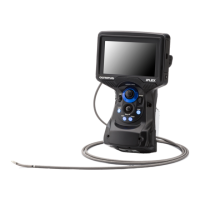92
Chapter 4 Operation
EVIS LUCERA GIF/CF/PCF TYPE 260 Series OPERATION MANUAL
• Transnasal insertion of the endoscope should be performed
carefully. If resistance to insertion is felt, or the patient reports
pain, stop the insertion immediately. Otherwise, patient injury
can result or the endoscope could become lodged and
difficult to withdraw.
• The endoscope position detecting unit is designed to only
assist the insertion of an endoscope. Never insert the
endoscope into the patient’s body by observing only the
endoscope position display of the endoscope position
detecting unit. Be sure to observe the endoscopic image and
insert the endoscope while confirming the safety. If the
endoscope is inserted without observing the endoscopic
image, patient injury, bleeding, and/or perforation can result
(for CF-Q260DL/I, CF-H260DL/I only).
• To prevent the patient from biting the insertion section during
an examination, it is strongly recommended that a
mouthpiece be placed in the patient’s mouth before inserting
the endoscope (for GIF models only).
• To prevent the patient from accidentally loosening a dental
prosthesis, make sure that the patient removes it before the
examination (for GIF models only).
• To prevent the patient from breaking one or more teeth, make
sure there are no missing teeth, or teeth that are not
permanently capped, etc., before the examination.
• Do not apply olive oil or products containing petroleum-based
lubricants (e.g., Vaseline
®
) to the endoscope. These
products may cause stretching and deterioration of the
bending section’s covering.
• Do not allow the insertion section to be bent within a distance
of 10 cm or less from the junction of the boot. Insertion
section damage can occur (see Figures 4.2 and 4.3).

